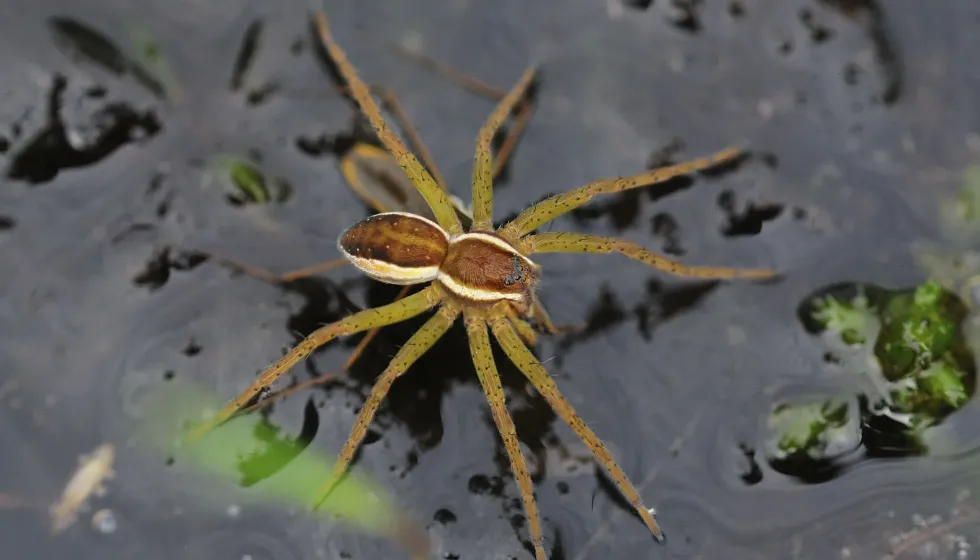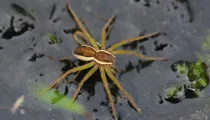Raft spider (Dolomedes species) is perhaps the biggest arachnid in the United Kingdom. Like different arachnids, they chase by running along the edge of the water and can move inside and out to stay away from predators.
Adult spiders prefer living away from water and are more likely to be found near the ground. Two subspecies of raft spiders are found in Britain, the raft spider (Dolomedes fimbriatus) and the fen raft spider (Dolomedes plantarius).
Here are some of the most interesting facts about the raft spider (Dolomedes species) for your perusal. For more information on anthropods found in our wildlife, you may also look at yellow sac spider facts and Brazilian wandering spider facts.
Raft Spider Interesting Facts
What type of animal is a raft spider?
Raft spider (Dolomedes Fimbriatus) is a type of spider species that is semi-aquatic and a dark brown colored member of the family pisauridae like the fen raft spider (Dolomedes plantarius).
What class of animal does a raft spider belong to?
Spiders are 8-legged creatures, a class of arthropods that resembles characteristics of scorpions, parasites, and ticks. They belong to the class Arachnida and have a large body, which is quite huge compared to other spider species.
How many raft spider are there in the world?
The conservation status of this species of spiders has not been evaluated by IUCN. As a result, there are no accurate numbers available regarding their population in the wildlife with any registered charity. Hence, their conservation status is not of any concern at present. But they are protected under the fifth Schedule of the Wildlife and Countryside Act 1981.
Where does a raft spider live?
Raft spider is a huge spider that lives around the edge of lakes and ditches, and on wet heaths and lowlands. This spider species has distinct features in the body that allow it to move along easily even on the surface of water just like water spiders.
What is a raft spider's habitat?
Raft spiders are semi-aquatic creatures occupying freshwater wetlands, explicitly wet heaths and marshes. Juveniles are found in abundance in regions with thick vegetation encompassing wetland regions.
Who does raft spider live with?
You can spot the brown colored raft spider living along with other members of the same species on the surface near water bodies. They prefer to live near water surface, as it allows them to catch their prey more easily.
How long does a raft spider live?
A raft spider can live from one to three years in the wildlife. Their conservation has been ensured under the fifth Schedule of the Wildlife and Countryside Act 1981.
How do they reproduce?
Water is fundamental for the growth of the raft spider, hence the breeding process takes place near such regions only. After the mating process has been completed, the female fen raft spider makes an egg sack and lays a few hundred eggs into it.
The female hauls the sack around with her for around three weeks for the conservation of the eggs.
What is their conservation status?
As per the records, the population of fen raft spider (Dolomedes plantarius) and raft spider (Dolomedes fimbriatus) is listed under the least concern category in terms of conservation with every registered charity. Yet, for the sake of their conservation, the fifth Schedule of the Wildlife and Countryside Act 1981 has been listed.
Raft Spider Fun Facts
What does raft spider look like?
Raft spiders is a stout, hefty arthropod, for the most part, brown colored in appearance with a particular pale stripe running from the head each side of its fat, stogie formed body. Body tone, stripe tone, and stripe width are for the most part amazing factors in this species.
These spiders have eight legs that help it float on the water.
How cute are they?
A fen raft spider is cute as people find this creature not that harmful. However, fen raft spider is poisonous and should be handled with care. The hairy legs and body render it a menacing appearance.
How do they communicate?
A fen raft spider communicates with other spiders through body movements and other visual cues. Raft spiders are known to generate a vibration for the purpose of communication.
How big is a raft spider?
The fen raft spider species is about 70 times smaller than the raft spider. Grown-up raft spiders are huge, with body measuring 0.87 in (2.2 cm) and the leg span being 2.8 in (7.1 cm). As with most insects, the male is smaller in size as compared to females.
How fast can a raft spider move?
A semi aquatic (Dolomedes plantarius) is a slow-moving spider that likes to stay idle at a position near the surface of the water. Their exact speed in the wildlife is not known.
How much does a raft spider weigh?
A fen raft spider usually weighs quite less. No concrete information is available regarding their body weight.
What are the male and female names of the species?
Male raft spiders are called males, whilst female raft spiders are called females.
What would you call a baby raft spider?
A baby raft spider is called a spiderling.
What do they eat?
Raft spiders are ruthless and stay near the water source where they can easily get their prey. They feed on amphibian spineless creatures, worms, dragonfly hatchlings, little fish, tadpoles and other sea insects.
Are they poisonous?
Yes, a fen raft spider is poisonous and can have a painful impact on a human if it bites. However, the (Dolomedes plantarius) species is not considered dangerous as their bites do not lead to death in humans and only causes minor pain and swelling.
Would they make a good pet?
Raft spiders can make incredible pets. They are, in general, not difficult to handle on and are intriguing to watch.
How do their webs work?
Raft spiders build silk strings using their web to build or form a network. They secure the string to an object, normally a branch, an edge of a room, a door jamb or any place and then start constructing its web.
How to get rid of raft spiders?
Essential oils: peppermint oil is a famous solution for disposing of insects. Robust aromas are incredible arachnid anti-agents. Replacing the oil that you use routinely can assist with guaranteeing that the cure keeps on being viable.
Vinegar: vinegar is known to ward arachnids off because they detest it more than felines disdain a hot shower. The smell of any sort of vinegar will creep them out. If you see an insect, shower it on the bug. Be mindful to stay away from stained surfaces as vinegar can be distasteful.
Ordinary cleaning: clean your home routinely. This doesn't permit an insect to fabricate a web. Tidying consistently fends the spider networks off.
Plant a eucalyptus tree in the nursery: Eucalyptus tree has a solid aroma and repulses arachnids.
Citrus: Arachnids disdain all citrus fragrances, so rub citrus strip along evading sheets, window ledges, and shelves. Utilize lemon-scented cleaners and furniture cleaner, and light citronella candles both inside and outside of your home.
Switch off outside lights: Turn off the external lights to keep bugs from drawing close to the house. Arachnids enter your home looking for food. These bugs are most regularly drawn to lights.
Cedar: Another fragrance that Arachnids are said to despise is cedar. Pulling a cedar plant into your house isn't by and largely useful, in any case.
Garlic: Garlic is a strong antioxidant that can be used to keep these predators at bay. Pour some on your shower every night but make sure the aroma leaves the next day.
Here at Kidadl, we have carefully created lots of interesting family-friendly animal facts for everyone to discover! For more relatable content, check out these six eyed sand spider facts and wolf spider facts for kids.
You can even occupy yourself at home by coloring in one of our free printable raft spider coloring pages.







